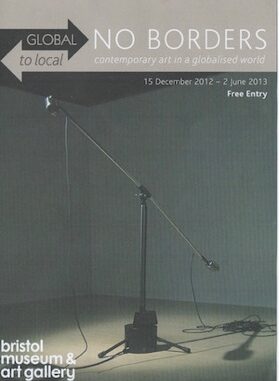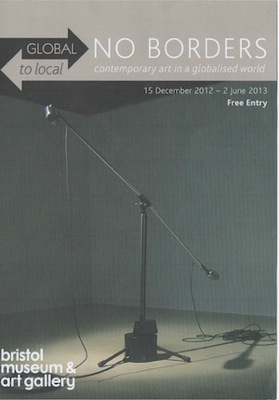
No borders is showing at the Bristol museum & art gallery until 2nd June 2013 and is a major contemporary art exhibition featuring the work of artists from around the world. It is divided into two rooms in the museum, one a white walled typical gallery space, the other wallpapered in a blue damask. In these spaces 14 artists explore notions of globalisation, history, migration and conflict.

The two spaces have different vibes, with the old damasked room seeming to present a colonial past from which the works on show are trying to escape. A few, such as the portraits of women by an unknown indian artist fit in, but the others jar. The surroundings exaggerate the meaning of the pieces, Imran Quareshi’s bloody handprints speaking of conflict and rebellion. Shilpa Gupta doesn’t like to be called a political artist, but her work often touches on the ethnic divisions of Pakistan and India. Her piece here sees two microphones seesawing up and down whilst political speeches from each side of the original partition are played out. It makes for a noisy visit, the hard to decipher words continually reminding you of the way partition completely affected so many people.
In the white walled room there is the large Ton of Tea by Ai Weiwei. Probably the star of the show this is still perfumed and makes a humourous comment on minimalist sculpture.

Ai Weiwei A ton of tea
The perfect cube of tea is large and slightly threatening with an odd bouquet. Your brain tells you that artworks aren’t supposed to smell, yet here it is sitting in the gallery exuding a sweet aroma. The tea is the Pur Er brand which is drunk all over China. The relocation of an artwork from China mocks the usual hi-tech Chinese products that find their way here and it sits in the gallery like a brazen interloper.
Other pieces in this gallery include the mini art gallery by Walid Raad complete with miniature video projections and documentary photographs of sugar cane plantation workers by the South African Zwelethu Mthethwa. These are pictured staring down the camera and are not the docile workers of Millet’s paintings. They are badly dressed and exhausted yet remain defiant.
One artist on show whose popularity needs explaining to me is Tala Madani, an artist from Tehran who now lives in New York and Amsterdam.

Tala Madani, Double Head Index
There is a crudeness to her painting that is seen elsewhere and can often allow other parts of the work to shine through. But with the deliberately restricted palette and the wantonly unreadable image I had a sense of the artist playing with me, daring me to stroke my chin and say Marvellous. The curator wrote that the meaning of Madani’s work remains elusive, and with that I can concur. If anyone has any pointers to how it should be interpreted please leave them in the comments below.

Leave a Reply